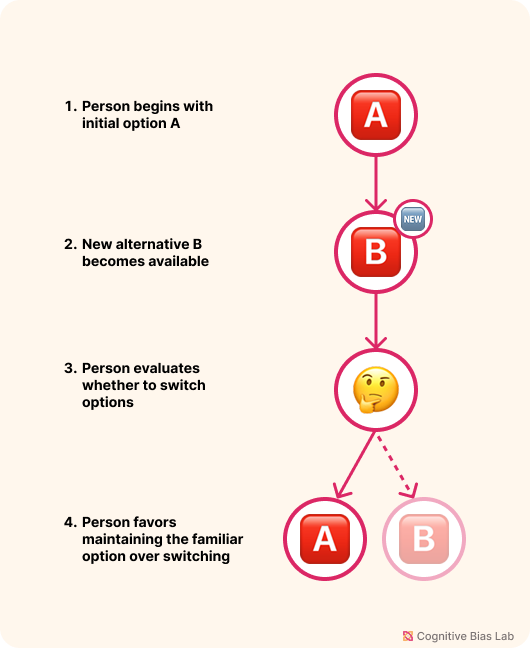Status Quo Bias
Your progress on this bias test won't be saved after you close your browser.
Understanding Status Quo Bias
Status Quo Bias
The tendency to stick with the current situation just because it’s familiar, often causing people to avoid change even when better options are available.
Overview
When faced with a decision, many people instinctively choose to keep things as they are, even when change could lead to better outcomes. This cognitive tendency to favor the existing state of affairs is known as status quo bias.
Why It Happens
At its core, this bias is driven by a mix of loss aversion, emotional comfort, and decision avoidance. Changing the current situation often brings uncertainty and the potential for regret. Even if the alternative has clear advantages, the fear of loss and the mental effort required to switch can feel more costly than staying the same. People also tend to view the current state as a default, which gives it more weight than it objectively deserves.
How It Affects Decisions
Status quo bias can shape choices in many areas of life. It shows up when employees resist new workplace systems, when investors hold on to poor-performing assets, or when users accept default options on websites without considering alternatives. It can even influence major personal decisions, such as staying in an unfulfilling relationship or job, simply because making a change feels too risky.
Not Just Inertia
This is more than just habit or indecisiveness. Research shows that people often stick with default options even when clearly better ones are available. For example, in retirement planning studies, participants were far more likely to choose suboptimal investment plans if those were the default selections.
Recognizing this bias can help us question whether we are making decisions based on quality or simply out of a preference for familiarity.

Visual representation of Status Quo Bias (click to enlarge)
Examples of Status Quo Bias
Here are some real-world examples that demonstrate how this bias affects our thinking:
Psychological Study Simulation
Status Quo Bias Simulation
Explore how framing affects decision-making, based on Samuelson, W., & Zeckhauser, R. (1988). Status quo bias in decision making. Journal of Risk and Uncertainty, 1(1), 7–59. This simulation demonstrates how the presentation of options as either status quo or new alternatives can significantly influence our choices.
The Healthcare Plan Inertia
During open enrollment, an employee is presented with a new healthcare plan that offers better coverage at the same cost as their current plan. Despite clear advantages, they feel anxious about switching and ultimately decide to keep their existing plan. They justify this by thinking, "At least I know how this one works," even though the new option would save them hundreds of dollars annually. This demonstrates how the comfort of familiarity often outweighs rational benefit analysis.
The Corporate Software Resistance
A marketing department has used the same project management software for five years, despite it being outdated and inefficient. When the IT team proposes a new platform with enhanced features and time-saving automation, the marketing team strongly resists. They argue that "our current system works fine" and cite concerns about transition difficulties. The real issue isn't the new software's capabilities (which are superior) but rather the team's psychological attachment to their familiar workflow.
How to Overcome Status Quo Bias
Here are strategies to help you recognize and overcome this bias:
Use a Cost-Benefit Comparison Sheet
List out the tangible and intangible pros and cons of both the current option and the alternative. Include estimates for time, money, and satisfaction. Review it with someone neutral to help reduce emotional bias.
Run Low-Risk Change Trials
Test the new option for a set period (2–4 weeks) while keeping the ability to revert. Track specific outcomes during this time to make a more informed, less biased decision.
Test Your Understanding
Challenge yourself with these questions to see how well you understand this cognitive bias:
A company has used the same supplier for 12 years. A new supplier offers identical quality with 15% lower costs, but the procurement manager decides to stay with the current vendor because "we know what we're getting." What's driving this decision?
Academic References
- Samuelson, W., & Zeckhauser, R. (1988). Status quo bias in decision making. Journal of Risk and Uncertainty, 1(1), 7–59.
- Miceli, A. C., & Suri, G. R. (2022). The role of attention in status quo bias. Quarterly Journal of Experimental Psychology, 76(9), 2122–2138.
- Kahneman, D., & Thaler, J. L. K. a. R. H. (1991). Anomalies: the endowment effect, loss aversion, and status quo bias. The Journal of Economic Perspectives, 5(1), 193–206.